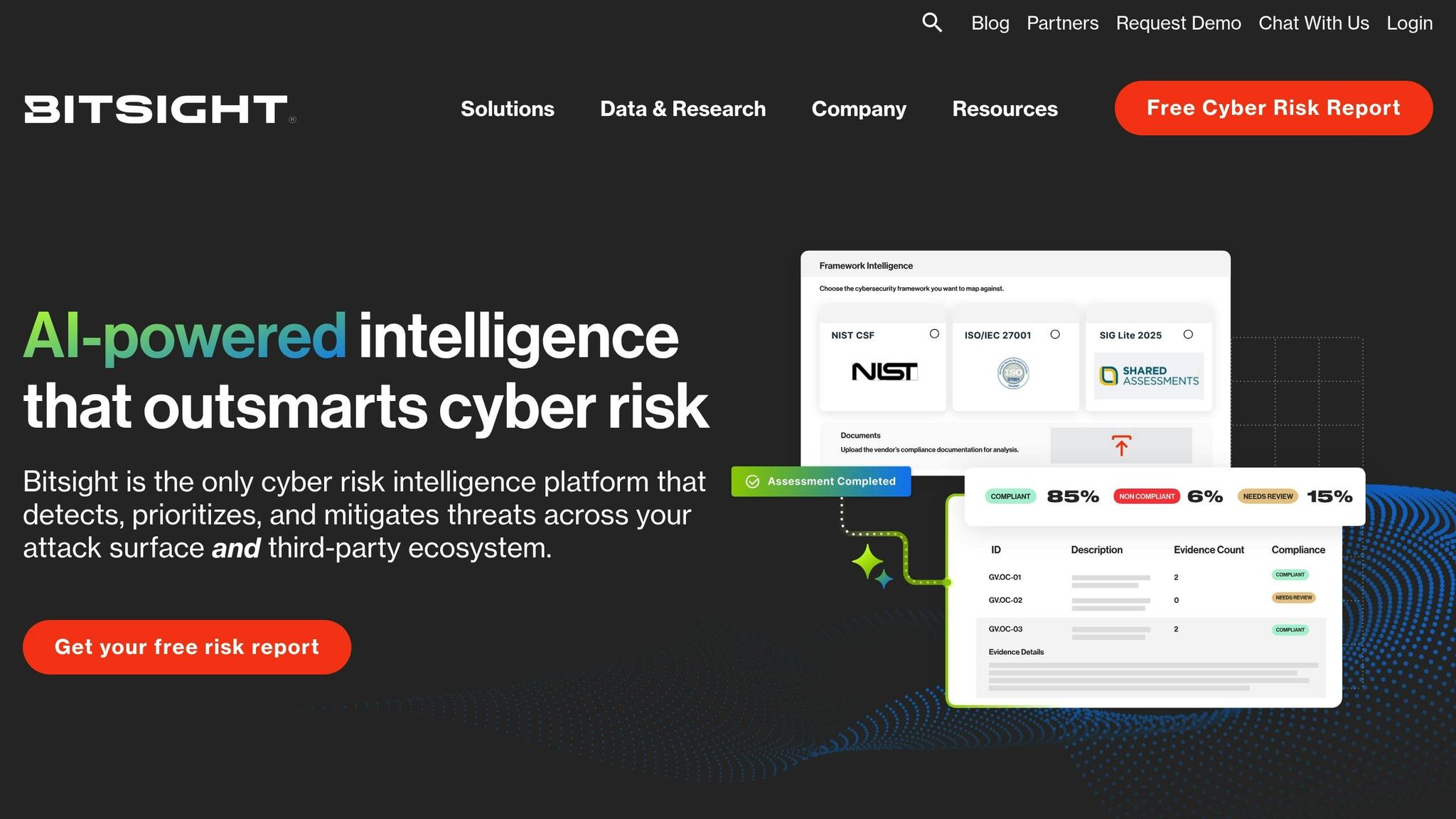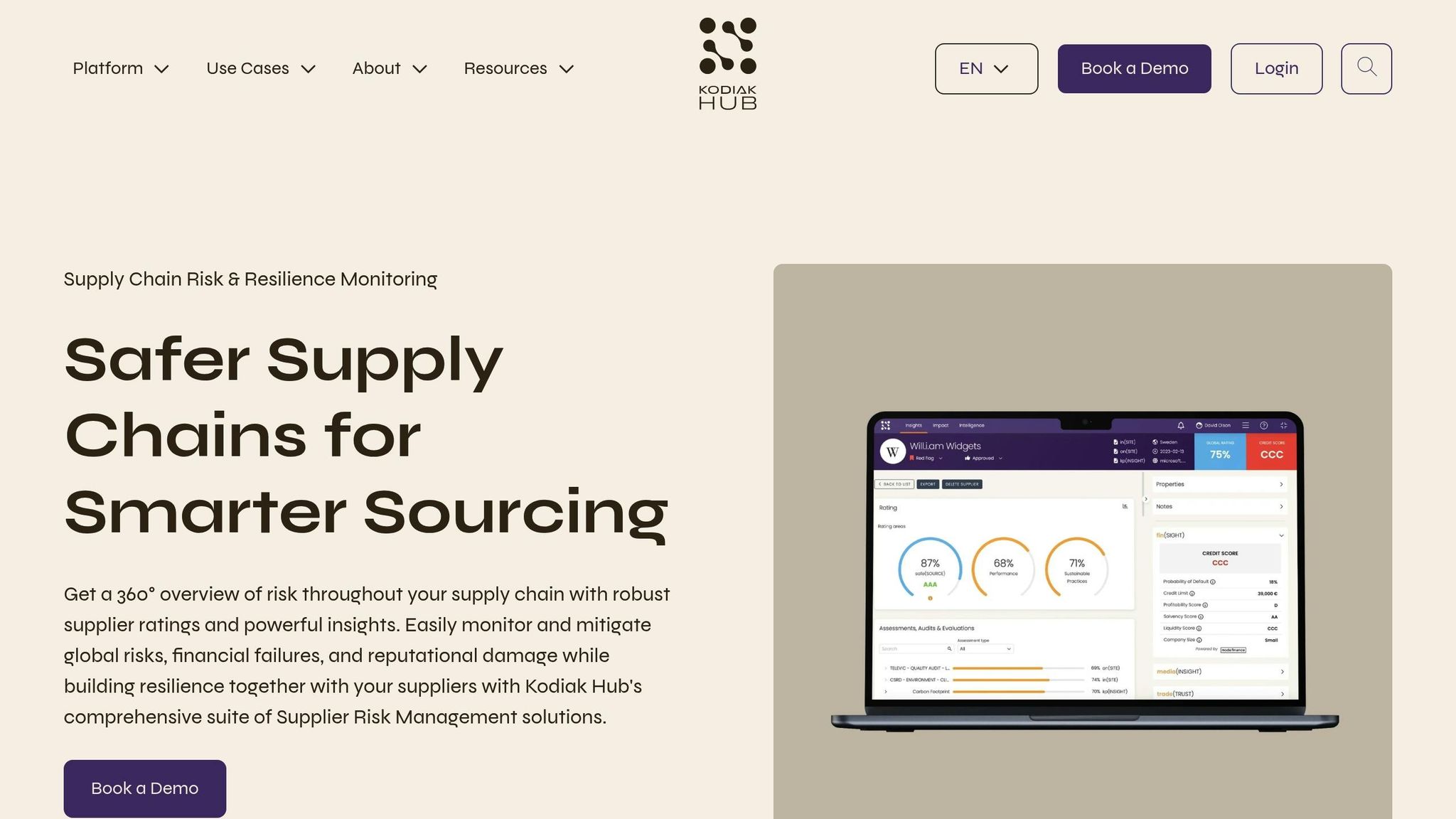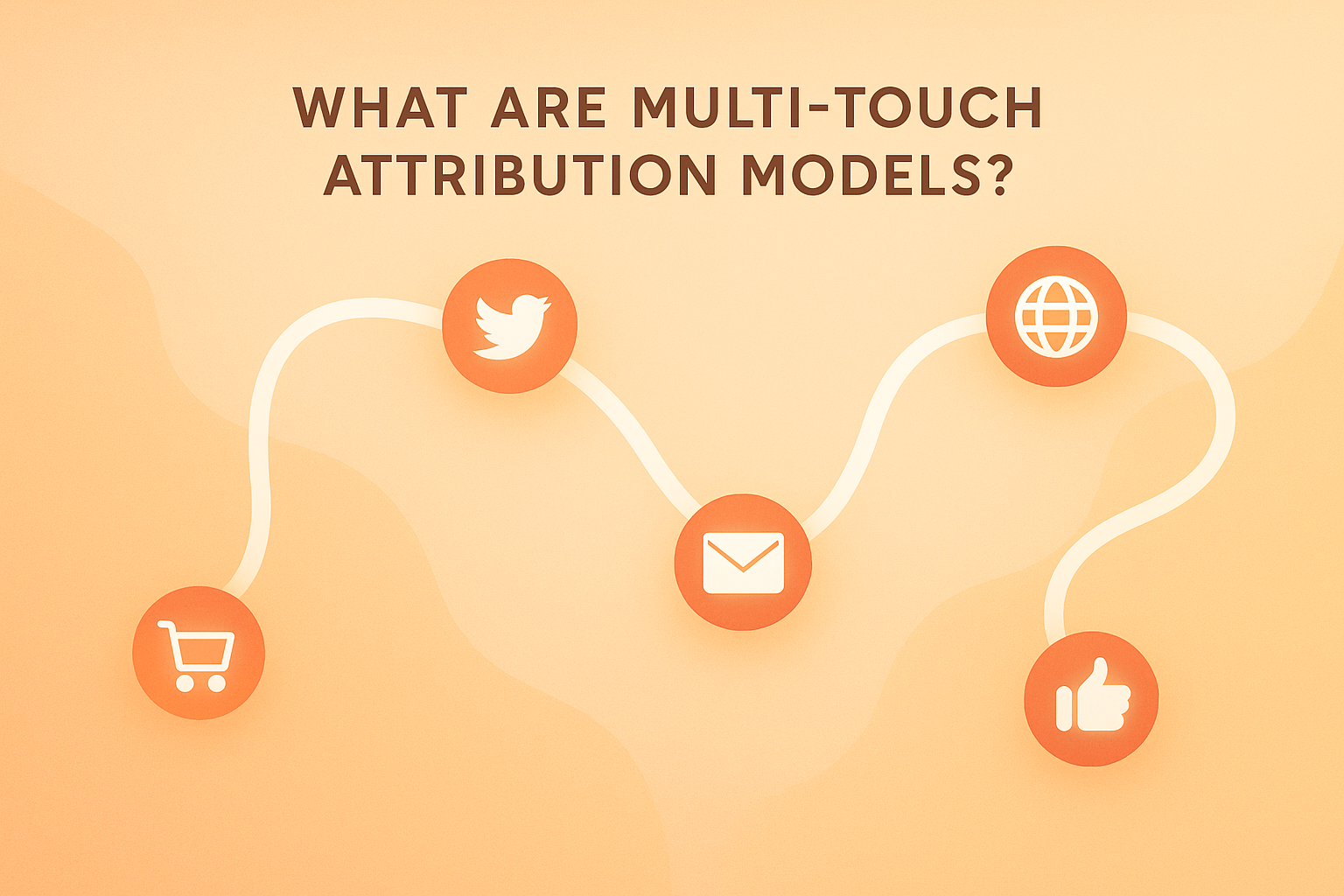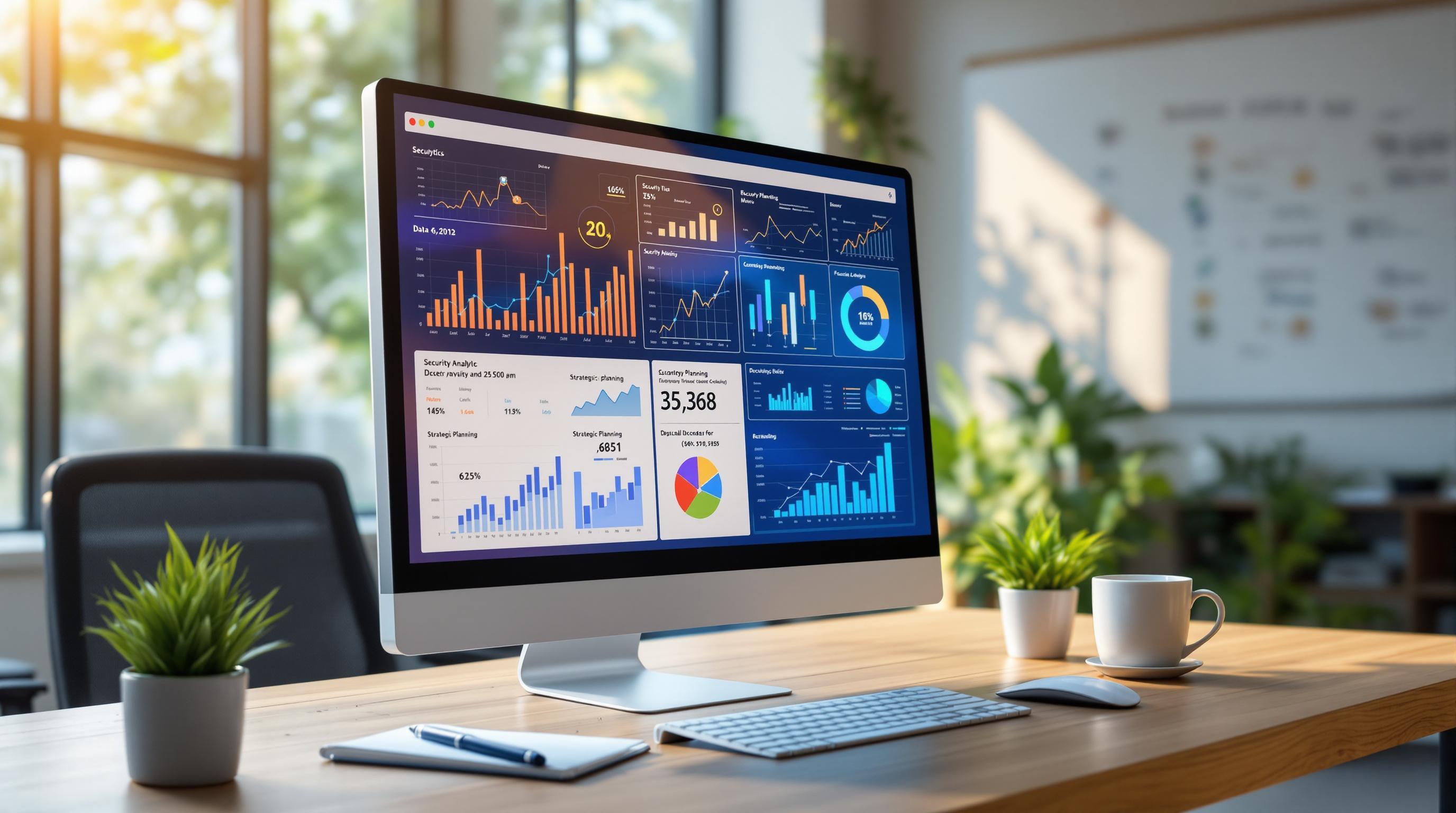Vendor risk assessments are critical for managing the risks third-party vendors can pose to your business. With increasing reliance on external services and stricter U.S. regulations like SOX, HIPAA, and CCPA, using the right tools can save time, improve accuracy, and ensure compliance. Modern tools automate processes, provide real-time monitoring, and integrate with your existing systems, replacing outdated manual methods like spreadsheets and emails.
Key Takeaways:
- Automation & Real-Time Monitoring: Tools offer automated risk scoring and real-time updates to address emerging risks.
- Regulatory Compliance: They include pre-built templates for U.S. laws and frameworks (e.g., SOX, HIPAA) and maintain audit trails for accountability.
- System Integration: Seamless integration with ERP, GRC, and communication platforms ensures efficient workflows.
Top Tools:
- Kodiak Hub: AI-driven risk scoring with financial and ESG insights.
- Venminder: Vendor lifecycle management with robust documentation.
- BitSight: Focused on cybersecurity and real-time threat intelligence.
- Panorays: Simplifies onboarding with automated security questionnaires.
- MetricStream: Advanced workflows and full GRC suite.
- Diligent: Governance-focused with executive dashboards.
- ServiceNow: Scalable platform for IT and risk management.
Quick Comparison
| Tool | Key Features | Best For | Pricing Model |
|---|---|---|---|
| Kodiak Hub | AI risk scoring, ESG monitoring | Balanced risk analysis | Modular subscription |
| Venminder | Lifecycle management, questionnaires | Comprehensive vendor oversight | Custom pricing |
| BitSight | Cybersecurity ratings, real-time updates | Cybersecurity-focused needs | Tiered subscription |
| Panorays | Onboarding, security questionnaires | Quick deployment | Per-vendor pricing |
| MetricStream | GRC suite, workflow automation | Large enterprises | Enterprise licensing |
| Diligent | Governance, executive dashboards | Board-level reporting | Premium enterprise pricing |
| ServiceNow | IT integration, scalable workflows | ServiceNow ecosystem users | Platform-based licensing |
Tip: Choose a tool based on your organization's size, risk priorities, and current systems. For financial insights, Kodiak Hub is ideal; for quick onboarding, Panorays shines. Large enterprises may benefit from MetricStream or ServiceNow.
Vendor risk management isn't static - regularly review tools to stay aligned with evolving risks and regulations.
Bitsight Vendor Risk Management Walkthrough

How to Choose Vendor Risk Assessment Tools
Picking the right vendor risk assessment tool is all about finding a solution that fits your current needs while being flexible enough to grow with your business. As your vendor network expands and regulations shift, the tool should be able to keep up. Here are the key features to focus on when making your decision.
Real-Time Monitoring and Automation Features
Real-time monitoring is critical for identifying and addressing risks as they emerge. Without it, you could miss serious issues like security breaches, financial troubles, or regulatory violations.
Look for tools that offer automated risk scoring based on factors like security ratings, financial health, and regulatory data. Automation ensures consistent evaluations across vendors while cutting down on manual work. The best tools can flag major risk changes automatically and even launch reassessment workflows without needing human input.
Another useful feature is automated distribution of customized assessments. Tools that can send out assessments, track responses, and issue reminders save you from the tedious administrative workload of manual processes.
Regulatory Compliance Requirements
Your chosen tool must align with the regulatory standards relevant to your business. For U.S. companies, this could include frameworks like SOC 2 Type II, HIPAA for healthcare vendors, PCI DSS for payment processors, and SOX for publicly traded companies.
The platform should offer pre-built templates tailored to these regulations, ensuring you ask the right compliance questions. This reduces the chance of missing critical requirements and simplifies the process of evaluating vendor adherence to regulatory standards.
An audit trail is another must-have feature. The tool should log all assessment activities, decisions, and communications with vendors. This is invaluable for regulatory audits or when you need to demonstrate due diligence after a vendor-related incident.
Additionally, tools that provide regulatory update notifications can help you stay ahead of changing laws, such as evolving state privacy regulations. This ensures your vendor risk processes remain up-to-date as rules change.
Integration with Business Tools
For a smoother and more secure risk assessment process, the tool should integrate seamlessly with your existing systems. For example, integration with your ERP system allows automatic syncing of vendor details, contracts, and financial data.
Single sign-on (SSO) is another important feature. Tools that support SSO providers like Active Directory, Okta, or Azure AD make it easier for your team to log in securely.
Look for a tool that connects with your Governance, Risk, and Compliance (GRC) platform. This integration enables you to view vendor risks alongside other business risks, helping you make better strategic decisions. Similarly, linking the tool to your contract management system ensures vendor performance aligns with contractual obligations and renewal schedules.
Having an API available is also a big plus. It allows for custom integrations with proprietary systems or specialized tools your business relies on. This flexibility ensures the tool can adapt as your technology stack evolves over time.
Finally, the tool should work with your business communication platforms to deliver risk alerts and updates directly to the right team members. This ensures critical information reaches decision-makers quickly without requiring extra steps or logins.
Top 7 Vendor Risk Assessment Tools
Kodiak Hub showcases how AI-powered solutions are reshaping vendor risk management. Here's an in-depth look at what makes Kodiak Hub stand out as a leading vendor risk assessment tool.
Kodiak Hub

Kodiak Hub leverages AI and machine learning to continuously monitor financial, operational, and ESG (Environmental, Social, and Governance) risks. By pulling data from sources like financial reports, industry news, and regulatory updates, it delivers a comprehensive supplier risk score in real time.
The platform also automates compliance checks and risk mitigation processes, saving time while maintaining accuracy. To enhance its capabilities, Kodiak Hub integrates global risk intelligence from trusted sources such as Dun & Bradstreet, EcoVadis, and Moody's. This integration ensures a unified, reliable risk score.
One standout feature is the fin(SIGHT) module, which dives deep into financial metrics like liquidity, profitability, and solvency. It provides detailed supplier ratings and an overall credit score, offering a clear picture of a supplier's financial health.
sbb-itb-5174ba0
Tool Comparison Table
Selecting the right vendor risk assessment tool means weighing each platform's strengths and limitations against your organization’s needs. Below is a detailed comparison of how these tools measure up across essential business criteria.
| Tool | Key Strengths | Limitations | Integration Capabilities | US Compliance Support | Pricing Model |
|---|---|---|---|---|---|
| Venminder | Extensive vendor lifecycle management, robust documentation workflows, and a large questionnaire library | Can be complex for smaller organizations, steep learning curve | Works with major ERP systems, Microsoft Office, and GRC platforms | Supports SOX, FFIEC, GDPR, and SOC compliance | Custom pricing based on vendor count |
| BitSight | Real-time threat intelligence, continuous security monitoring, and strong security ratings | Limited financial risk assessment, primarily focused on cybersecurity | APIs for SIEM tools, ticketing systems, and security orchestration platforms | Aligned with SOC 2, ISO 27001, and NIST frameworks | Tiered subscription model starting at enterprise level |
| Kodiak Hub | AI-driven risk scoring, real-time ESG monitoring, and comprehensive financial analysis through fin(SIGHT) | Newer platform with fewer legacy integrations, evolving feature set | Integrates with Dun & Bradstreet, EcoVadis, Moody's, and leading BI tools | Covers SOX, COSO, and regulatory reporting | Subscription-based with modular pricing |
| Panorays | Intuitive interface, automated security questionnaires, and efficient vendor onboarding | Limited operational risk coverage, security-focused | REST APIs and integrations with ServiceNow, Jira, and major cloud platforms | Supports SOC 2, ISO certifications, and GDPR compliance | Per-vendor pricing model |
| MetricStream | Comprehensive GRC suite, advanced workflow automation, and detailed reporting | Complex implementation requiring significant IT resources | Extensive ERP integrations and connections with major business apps | Full US regulatory compliance, including SOX, COSO, and NIST | Enterprise licensing with additional implementation costs |
| Diligent | Strong governance features, board-level risk reporting, and executive dashboards | High cost, potentially excessive for mid-market companies | Works with board management systems, Microsoft 365, and enterprise apps | Offers a complete US regulatory compliance framework | Premium pricing for enterprise clients |
| ServiceNow | Scalable platform, powerful workflow automation, and excellent IT integration | Requires ServiceNow ecosystem, complex customizations | Native ServiceNow suite integration with extensive third-party connectors | Includes SOX, NIST, and industry-specific compliance modules | Platform-based licensing with optional modules |
Key Considerations: Cost, Deployment, and Features
Financial Investment: Tools like MetricStream and Diligent cater to large enterprises with annual costs in the six-figure range. Mid-market options such as Panorays and BitSight offer more affordable entry points, while Kodiak Hub’s modular pricing lets companies scale based on specific needs.
Deployment Time and Complexity: Platforms like ServiceNow and MetricStream require significant IT resources and can take 6–12 months to implement. In contrast, Panorays and BitSight deploy in just a few weeks, making them ideal for organizations that need quick solutions.
Specialized Features: BitSight shines in cybersecurity risk assessment but may need supplemental tools for broader risk management. Kodiak Hub offers a balanced approach with AI-powered insights across financial, operational, and ESG risks. Meanwhile, Venminder provides a full vendor lifecycle management solution, making it a versatile choice for comprehensive risk management.
Ultimately, your decision will depend on factors like company size, existing tech infrastructure, and specific risk priorities. For instance, businesses already using ServiceNow may benefit from its seamless integration, while those prioritizing financial risk analysis might find Kodiak Hub’s analytics capabilities more appealing.
Conclusion
Choosing the right vendor risk assessment tool goes beyond simply checking compliance boxes. It's about strengthening your organization's defenses against third-party risks while keeping operations running smoothly. The tools we've covered - ranging from BitSight's real-time cybersecurity insights to Kodiak Hub's AI-powered risk scoring and Venminder's end-to-end vendor management - each bring something unique to the table.
Regulations are becoming stricter, with frameworks like SOX and NIST, along with industry-specific standards, pushing for more thorough vendor oversight. At the same time, the growing complexity of cyber threats continues to test organizations across all industries.
When deciding on a tool, focus on three key factors: your organization's risk tolerance, current technology setup, and future growth plans. For instance, a mid-sized company might benefit from Panorays' quick deployment and streamlined features, while a large enterprise already using ServiceNow could take advantage of its robust platform. For organizations placing equal weight on ESG factors and risk management, Kodiak Hub's integrated approach might be the perfect fit.
Vendor risk assessment isn't a "set it and forget it" process. With new threats, evolving regulations, and changes in your vendor ecosystem, regular reviews of your tools are essential. Conducting annual evaluations ensures your risk management strategy stays aligned with current needs. This could mean upgrading features, switching platforms, or adding specialized tools to address new challenges.
The right tool does more than meet compliance - it boosts efficiency and decision-making. A well-implemented risk program can lead to faster vendor onboarding, fewer security issues, and stronger partnerships with suppliers, paving the way for growth without compromising safety.
Take the time to assess your options thoroughly. Bring in input from IT, compliance, and procurement teams, and consider starting with a pilot program before committing. The right vendor risk assessment tool can seamlessly integrate into your broader risk management plan, becoming a vital part of your organization's operations.
FAQs
How do vendor risk assessment tools help businesses comply with regulations like SOX and HIPAA?
Vendor risk assessment tools are essential for businesses aiming to meet regulatory standards like SOX and HIPAA. They help pinpoint and address security risks tied to third-party vendors, ensuring sensitive data stays secure and compliance requirements are fulfilled.
These tools simplify the vendor evaluation process by automating risk assessments, keeping tabs on vendor performance, and implementing effective controls. This approach not only lowers the risk of data breaches and costly non-compliance penalties but also offers actionable insights to enhance a company’s security measures and manage compliance more effectively.
What should businesses look for when choosing a vendor risk assessment tool?
When choosing a vendor risk assessment tool, look for features that can automate risk detection and scoring. This not only saves time but also ensures a more accurate evaluation process. Customizable checklists are another must-have, as they help tailor assessments to your specific requirements and make the entire process more manageable.
Make sure the tool covers various risk categories, including cybersecurity, financial, operational, and reputational risks. A well-rounded approach like this helps safeguard your business from multiple angles.
It's equally important that the tool facilitates cross-departmental collaboration and aligns with your organization's unique goals. Lastly, ensure it complies with U.S. regulations to keep your risk management practices both compliant and efficient.
Can vendor risk assessment tools work with my current business systems? What are the advantages of integrating them?
Yes, vendor risk assessment tools can work seamlessly with your current business systems, such as procurement platforms, CRM software, or compliance management tools. These integrations enable automated workflows, real-time risk tracking, and better insight into vendor-related risks.
By linking these tools to your existing systems, businesses can simplify the risk assessment process, cut down on manual work, and spot potential problems faster. This not only boosts efficiency but also helps ensure compliance and improves overall vendor management.


